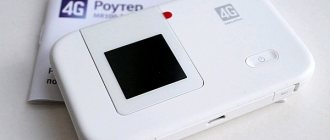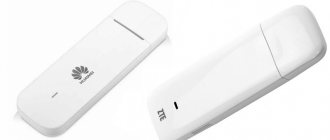When mobile Internet is required not only on a smartphone, but also on a computer or laptop while traveling, you cannot do without an LTE modem. Almost every telecommunications company has its own tariffs for this case. They differ quite a lot and have their own nuances, which are difficult to understand right away. Let's find out which operator has the best favorable tariffs for modems.
Favorable tariffs for a modem from the MTS operator
Those who prefer the MTS operator can choose for their USB modem one of the tariffs without a monthly fee, to which you can connect Internet options. Favorable tariff plans for a modem are “Per Second” or “Super MTS”. When activating a new number, only the “Super MTS” tariff is available, and you can switch to “Per Second” only through your personal account. It is to them that Internet packages are connected at no extra cost:
- Internet Mini - 7 GB for 520 rubles. per month;
- Internet Maxi - 15 GB for 835 rubles. and unlimited at night;
- Internet VIP - 30 GB for 1250 rubles. per month and unlimited at night.
You can use the Internet throughout Russia. Unused traffic balances, like other operators, are not carried over to the next month. Users of the “Maxi” and “VIP” options also receive a discount on MTS-TV from 30 to 50 percent. You can also connect to a special tariff package “For a laptop”. Its main advantage is unlimited traffic throughout Russia. The tariff is valid throughout the country without additional payments, and its cost is 850 rubles per month.
For laptop
Promotion
For the Internet
For modem
590 rub.
Subscription fee
- Access without speed limit for 100 rubles/month
- Unlimited Internet in Russia
- Optimal speed 20 Mbit/s
- 150 channels on Mobile TV and a library of films and cartoons
250 rub.
Connection
Add to cart
However, this tariff package has one feature that will upset fans of high speeds. Unlimited traffic is provided at speeds up to 10 Mbit/second. This speed is optimal for most users, and even allows you to watch videos online in high definition. The speed may be low if you need to quickly download a large file. But the user can remove the speed limit for three (for 99 rubles) or six hours (for 160 rubles), or for a month (for 350 rubles), while maintaining unlimited traffic. Options are activated upon user request.
Internet for summer residents. We get maximum speed in 4G networks. Part 1: Choosing the right router
Several years ago, I already conducted a review of communication means for a summer resident or someone living in his own home, where broadband Internet access is not available or costs so much money that it is easier to move to the city. Since then, quite a few terabytes have been transferred and I became interested in what is now on the market for good network access via LTE or 4G. So, I collected a few old and new routers with the ability to work over cellular networks and compared the speed and their functions. For results please see cat. According to tradition, if someone is too lazy to read, they can watch the video.
To begin with, I did not set myself the task of finding out which cellular operator provides the best speed, but decided to find out which modem/router provides higher speed under the same conditions. Beeline was chosen as the provider. The following operators are available in my region: Beeline, MTS, Megafon, Tele2, Yota, WiFire. “Striped” was chosen only because I already had its SIM card. I don’t give preference to any of the providers - each of them just makes money.
Testing methodology
The distance to the base station, in a straight line, is about 8 km, according to the router.
All tests were carried out on a weekday from 11 to 13, since at this time there is the least load on the 4G network. As a matter of principle, I do not consider 3G networks in the test, since they also carry the load of voice communications, and only data is transmitted over 4G. To forestall talk about VoLTE, I will say that voice over LTE has not yet been launched at the testing site. The test was carried out three times using the Speedtest service, the data was entered into a table and the average download, data transfer and ping speeds were calculated. Attention was also paid to the capabilities of the router. Testing conditions: clear weather, no precipitation. There are no leaves on the trees. The height of the equipment is 10 meters above the ground. Tests for all devices were carried out separately for a “bare” router, in the factory configuration. The second test was carried out when connecting to a small directional antenna, if the device has the appropriate connectors. The third test was conducted with a connection to a large panel antenna.
In the last column I added the final cost of the solution: for example, a router + modem + antenna can receive better than just a router, but cost less. Color grading has been introduced to visually identify a particular base device to which an additional antenna can be connected.
I will provide a scan of the radio broadcast to understand the conditions of signal reception and the presence of a BS within the operating radius of the router.
Small antenna LTE MiMo INDOOR
TTX:
Antenna design: Indoor Antenna type: wave channel Supported communication standards: LTE, HSPA, HSPA+ Operating frequencies, MHz: 790-2700 Gain, max., dBi: 11 Voltage standing wave ratio, no more than: 1.25 Characteristic impedance, Ohm: 50 Dimensions assembled (without fastening unit), mm: 160x150x150 Weight, no more, kg: 0.6
Large 3G/4G OMEGA MIMO antenna
TTX:
Antenna design: outdoor Antenna type: panel Supported communication standards: LTE, WCDMA, HSPA, HSPA+, DC-HSPA Operating frequencies, MHz: 1700-2700 Gain, max., dBi: 15-18 Voltage standing wave ratio, no more : 1.5 Characteristic impedance, Ohm: 50 Dimensions assembled (without fastening unit), mm: 450x450x60 Weight, no more, kg: 3.2 kg
Huawei E5372
TTX:
Network support: 2G, 3G, 4G Protocol support: GPRS, EDGE, HSPA+, HSUPA, HSDPA, LTE-FDD 2600, LTE-FDD 1800, LTE-TDD 2300
An old, but very lively router. Works in 2G/3G/4G networks. Has connectors for connecting an external antenna. Equipped with a built-in battery, which is enough for a couple of hours of very dense work on the network or 5 hours of leisurely surfing. There is a place to install a microSD card, which is available when accessed via a local wireless network. The cost is not too high, and when connected to a small or even large antenna through various pigtails and cable assemblies, it produces a very decent result, taking fourth place in the speed rating. The router is very convenient when traveling and driving, as it takes up little space, but provides Internet access to everyone within a short range. This is where the disadvantages come from: the range of the router is not very large - it will not cover the entire area of the dacha. There are no Ethernet ports, which means that wired IP cameras and other network equipment that want to connect to the network via cable cannot be connected. It only supports Wi-Fi 2.4 GHz, so in places with a large number of networks, the speed may even be limited. Overall, an excellent mobile router for working in the fields.
+
good battery life, support for all types of cellular networks, high data transfer speeds when connecting external antennas
—
inability to connect wired equipment
Keenetic Viva+modem MF823
TTX MF823:
Network support: 2G, 3G, 4G Protocol support: LTE-FDD: 800/900/1800/2600MHz; UMTS: 900/2100MHz; EGPRS/GSM: 850/900/1800/1900MHz; LTE-FDD: DL/UL 100/50Mbps (Category3)
The only router in this test that does not itself work with cellular networks, but it has two USB ports and support for almost all USB modems that work with cellular networks. Moreover, you can connect an Android or iOS smartphone to USB and the router will use them as a modem. In addition, Keenetic Viva can use any Wi-Fi source as a source of Internet access, be it neighbors’ Internet, a public access point, or shared Internet from a smartphone. Well, at home, this router connects to the network via a regular Ethernet cable and allows you to work in networks at speeds of up to 1 Gigabit per second. That is, a universal harvester that can be used both at home and in the country. Plus, you can connect an external drive to a free USB port (there are two in total) and the router itself will start downloading torrents or act as a local server for storing video from CCTV cameras. As for working with 4G networks via a modem, this combination took second place in the test, although this required connecting a large external antenna. But even without it, for only 9 thousand rubles, you can get an excellent router with a lot of functions and stable Internet access. It’s nice that the 4G modem can be used as a backup channel: when the wired provider “falls”, the router itself will switch to working from a USB modem. And if the modem freezes, the router will reboot it using power. A wonderful combine, and that’s all.
+
An excellent combination of a router and a modem will provide Internet access both in the apartment and in the country. Works with almost all modems. Great functionality
—
Doesn't work with cellular networks without a modem
TP-Link Archer MR200 v1
TTX:
Network support: 3G, 4G Protocol support: 4G: FDD-LTE B1/B3/B7/B8/B20 (2100/1800/2600/900/800MHz) TDD-LTE B38/B39/B40/B41 (2600/1900/2300 /2500MHz) 3G: DC-HSPA+/HSPA+/HSPA/UMTS B1/B8 (2100/900MHz)
This router exists in three modifications - v1, v2 and v3. The fundamental difference is that modification v1 has external antennas for 3G/4G networks, and Wi-Fi antennas are built-in. Other versions have the opposite. That is, you can connect an external antenna to the first modification, but not to the second and third. It should be noted that the router has good basic antennas with good gain. The functionality of the firmware is also quite rich, although it is inferior to the model from Keenetic. Standard SMA connectors are ready for connecting an external antenna, which, in my case, tripled the speed. But the router also has disadvantages: judging by the forums, TP-Link’s technical support is extremely weak, firmware updates are rarely released, and there were a lot of defects/glitches in the first modification, which is so valuable for “dacha residents.” In my case, the router has been working without problems for several years. He traveled with me to many cities, worked in the fields, powered by an inverter in the car, providing the Internet to the whole company. A decent router if you find the first modification.
+
Communication via a cellular network with external antennas (v1), which can be replaced to improve reception. A simple and functional device.
—
There are a lot of complaints about glitches and defects in the desired modification of the router.
Zyxel Keenetic LTE
TTX:
Network support: 4G Protocol support: 791 – 862 MHz (Band 20, FDD), 1800 MHz (Band 3, FDD), 2500 – 2690 MHz (Band 7, FDD)
An old, but still relevant model from Zyxel. The router is very rich in functionality: sensitive LTE antennas, SMA connectors for connecting external antennas, two ports for connecting analog telephones, 5 Ethernet ports, a USB port. In fact, this router is a whole combine that will provide both the Internet and the phone, fortunately there is a built-in SIP client. In addition, the LTE module can serve as a backup Internet connection if the main wired channel stops working. That is, the router can work both at home (in the office) and in the country. The USB port can be used to connect an external drive or printer. As speed tests show, it is only slightly inferior in downloading to the TP-Link Archer MR200, while its price is a third lower. The model has been discontinued, but is easy to find on the secondary market. There are only a couple of disadvantages: it only works on 4G networks and does not receive firmware updates. The second is not so important, since the current firmware is quite stable and functional, but working only in 4G networks suits me quite well - after all, it is in these networks that cellular companies operate that provide unlimited Internet.
+
The router is rich in functions, allows you to connect an external antenna, you can connect a telephone
—
Works only in LTE networks, firmware is not updated
Zyxel LTE3316-M604
TTX:
Network support: 3G, 4G Protocol support: HSPA+/UMTS 2100/1800/900/850 MHz (Band 1/3/5/8), WCDMA: 2100/1800/900/850 MHz, LTE FDD 2600/2100/1800/ 900/850/800/700 MHz, LTE TDD 2600/2500/2300 MHz
A very interesting router, which is a logical continuation of the Zyxel Keenetic LTE, but with changed hardware and design. The stylish little white device still has a pair of outputs for connecting an external antenna, thereby demonstrating support for MIMO technology. This is all the more interesting, because the router supports data transfer in both 3G and 4G networks. But it differs from the old model in the absence of a USB port and only one FXS connector, that is, you can connect only one analog telephone set. By the way, this model does not have a built-in SIP client and calls will be made through the installed SIM card. If the network supports VoLTE, you can continue to work with the network and communicate at the same time, otherwise, the router will switch to 3G and Internet access may be interrupted. Again, if compared with the previous model, the menu’s information content has become worse, but the speed indicators on the LTE network are delightful! The previous model Zyxel LTE3316-M604 is almost one and a half times faster, both when connecting an external antenna and when working with the built-in one. It can work with two Internet providers (wired and LTE) and switch to a backup one if the main channel fails. Overall, a highly specialized router, but with a decent modem!
+
Excellent speed performance, the ability to connect an analog telephone for calls via a SIM card
—
Not very informative menu, lack of SIP client
Zyxel LTE7460-M608
TTX:
Network support: 2G, 3G, 4G Protocol support: GPRS, EDGE, HSPA+, HSUPA, LTE TDD 2300/2600 MHz, LTE FDD 2600/2100/1800/900/800 MHz
The evolution of the legendary Zyxel LTE 6101 router in the form of a single unit - Zyxel LTE7460-M608. Everything about this model is very interesting: the antenna itself, the 2G/3G/4G modem and the router are hidden in a sealed unit and can be installed outdoors without fear of any weather conditions. That is, even in our latitudes, such a device will fully survive both hot summer and fierce winter. There is also a younger model, LTE7240-M403, but it is guaranteed to work only down to -20 degrees, while the Zyxel LTE7460-M608 can withstand temperatures down to -40. In general, this device is perfect for those who don’t want to bother with external antennas, cable assemblies, running additional wires, and so on. The antenna is hung in the direction of the base station using the supplied bracket, only one Ethernet cable is supplied, which also carries power (the PoE injector is located in any convenient place in the room), and then the user receives an Ethernet cable with access to the World Wide Web. It’s true that for comfortable work you need to install a wireless access point or some kind of router to organize a home wired and wireless network. As for the speed characteristics, this router made all the other models until... Until a large panel antenna was connected to the other devices. Still, 2 built-in antennas with a gain of up to 8 dBi are inferior to a large panel antenna with a gain of up to 16 dBi. But as a ready-made solution for installation and operation, it can be recommended.
+
Works in 2G/3G/4G networks, excellent reception, works in all weather conditions, laying just one cable to the installation site.
—
You will need a separate Wi-Fi router to organize a wired and wireless network at home.
results
Looking at this histogram, it immediately becomes clear how much the reception and transmission speed depends on the antenna gain. In addition, during the first test, without using external antennas, the sensitivity of the modems’ own antennas and radio modules is obvious. The use of a directional panel antenna increased the communication speed by three times - isn’t this the result when you want a lot of Internet for little money? But do not forget that purchasing a router does not guarantee good communication and you need to add an antenna, especially when the communication tower is not visible to the naked eye. Sometimes, the cost of an antenna may be equal to the cost of a router, and here it’s worth considering purchasing a ready-made device, like the Zyxel LTE7460-M608, where the antenna and router are assembled together. In addition, this solution is not afraid of temperature changes and precipitation. But you can’t take a USB modem or a regular router outside, and they will have a hard time in a regular attic - in the summer they will freeze due to overheating, and in the winter they will simply freeze. But increasing the length of the cable assembly from the antenna to the receiving device can negate all the benefits of installing a good, expensive antenna. And here the rule applies: the closer the radio module is to the antenna, the lower the losses and the higher the speed. For those who like numbers, I collected the results of all tests in a table, and the last column was the cost of assembly. This or that device with or without the addition of antennas is highlighted in color - this is to facilitate the visual search of results.
Separately, I decided to test the operation of the router without an obstacle and with an obstacle in the form of a double-glazed window. That is, simply by installing the Zyxel LTE7460-M608 router behind and in front of the window. The reception speed dropped imperceptibly, but the transmission speed decreased almost threefold. If the glass has any coating, the results will be even more disastrous. The conclusion is obvious: there should be as few obstacles as possible between the antenna and the base station.
conclusions
Based on the measurement results, it is obvious that the capabilities of the communication modules built into routers differ significantly, but even without an additional antenna, this speed is quite enough for watching videos or video conferencing via Skype.
However, it is quite obvious from the graphs that the use of an antenna can increase the speed several times. But here a balance must be maintained between the funds invested and the result obtained. For example: by purchasing a Zyxel LTE3316-M604 and a panel antenna, you can get results even better than the finished Zyxel LTE7460-M608 device. But then the panel antenna will be almost twice as large, and the router must be placed in close proximity to the antenna - this can cause difficulties. As a result, the winner in the speed test is the Zyxel LTE3316-M604 with a large panel antenna. You need to tinker a little with the direction of the antenna, and the router’s interface is only in English and may cause some discomfort. The winner in the functionality test is Keenetic Viva with a 4G modem. This router can work both in an apartment with classic Internet, and in a country house, where only cellular networks are available from providers. The winner in the test of ready-made solutions is Zyxel LTE7460-M608. This all-weather router is good because it can be placed anywhere, it is not afraid of any weather conditions, but for full operation it will need a Wi-Fi access point, a mesh system or an organized LAN. For frequent trips and trips by car, the Huawei E5372 mobile router is well suited - it can work both autonomously and when connected to a charger or power bank. Well, if you want maximum speed for a minimum of money, then you should look for the TP-Link Archer MR200 v1 - it has a good radio module and the ability to connect an external antenna, although there were defective copies.
Announcement
I was fascinated by the idea of achieving maximum speed at a great distance from the base station of a cellular operator, so I decided to take the most powerful router and test it with three types of external antennas: circular, panel and parabolic. The results of my experiments will be published in the next issue.
Tariffs and options for a modem from the Tele2 operator
The youngest federal operator traditionally offers more affordable tariffs. The basic one in the line for a USB modem is “Internet for Devices,” which in the updated version is a constructor. By choosing this tariff, the user has the opportunity to activate additional options, depending on the device used to access the Internet. They are paid once a month, and at any time you can change the option, or turn it off if there is no need to use the Internet.
- The basic cost of the tariff is 700 rubles per month;
- Unlimited modem at 4 Mbit speed 1100 rubles per month;
- 40 GB without speed limit 200 rubles per month.
An exclusive “For Internet” tariff is also offered, which is similar to the offer from Beeline. However, the price will be even lower and the traffic will be much greater. So, 30 GB costs 240 rubles, and 300 GB costs only 750 rubles per month.
The exclusive tariff can be used throughout Russia without additional payments at maximum speed in the operator’s network.
Which SIM card to choose for a modem
It is advisable to choose a SIM card that works equally well with both 3G networks and more modern and faster 4G networks. Recently, they are beginning to actively gain popularity, so choosing a SIM card with 4G support will come in handy. In addition, 4G SIM cards provide the user with the opportunity to enjoy all the benefits of high-speed Internet.
In this article we will talk about several of the most popular tariff plans from well-known companies that are designed specifically for modems. If you are a customer of the following operators, then we can tell you about inexpensive but practical tariffs that are great for distribution to other devices.











